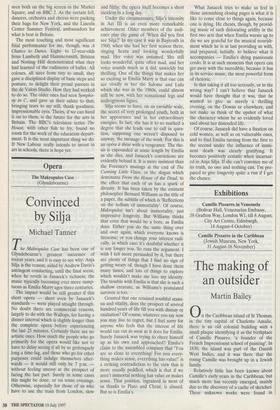Exhibitions
Camille Pissarro in Venezuela (Bolivar Hall, Venezuelan Embassy, 58 Grafton Way, London Wl, till 8 August; City Art Centre, Edinburgh, 14 August-4 October)
Camille Pissarro in the Caribbean (Jewish Museum, New York, 31 August-16 November)
The making of an outsider
Martin Bailey
On the Caribbean island of St Thomas, in the tiny capital of Charlotte Amalie, there is an old colonial building with a small plaque identifying it as the birthplace of Camille Pissarro, 'a founder of the French Impressionist school of painting'. In 1830, the island was part of the Danish West Indies, and it was there that the young Camille was brought up in a Jewish family.
Relatively little has been known about Camille's early years in the Caribbean, but much more has recently emerged, mainly due to the discovery of a cache of sketches. These unknown works were found in Olana, an Arabian-style palace which tow- ers above the Hudson River in upstate New York. This extraordinary building was the home of the American landscape painter Frederic Church, who died in 1900.
Recently, a portfolio of drawings and oil sketches at Olana was examined and found to contain 150 works by Pissarro. These had arrived by a circuitous route: they were given by Pissarro to a close friend, the Danish artist Fritz Melbye, who later left them for safekeeping with Frederic Church. Melbye died on a visit to China and the Pissarro sketches remained in a dusty folder in Olana.
Earlier this year, the finest of the Olana sketches were brought back to St Thomas for an exhibition organised by the local syn- agogue, whose worshippers once included the Pissarro family. The small island (popu- lation 50,000), now part of the US Virgin Islands, is way off the usual international art circuit, and this was the first major exhi- bition ever held in Charlotte Amalie. The temporary return of the Pissarro sketches after nearly a century and a half was an emotional experience for the islanders. From late August, the Olana works will be shown at the Jewish Museum in New York.
Here in Britain there is another opportu- nity to explore the work of the young artist, thanks to a separate exhibition organised by the Venezuelan Embassy. In 1852, the 22-year-old Pissarro had gone to Caracas, accompanying his Danish friend Melbye. Pissarro later explained his reasons for leaving his well-paid job as a clerk in St Thomas: he wanted to escape 'the bondage of bourgeois life'. Pissarro stayed m Venezuela for nearly two years, sketching the lush tropical landscape and everyday life in the sleepy capital of Caracas. Although virtually all of Pissarro's sketches of Caracas and its surroundings ended up in Europe, over 200 works have now been acquired by Venezuelan owners, a tribute to the tenacity of the country's collectors and museums. The London exhi- bition, which moves to Edinburgh for the Festival, therefore offers a unique opportu- nity to see the Pissarros. On show are 60 drawings and watercolours, along with three oil paintings of Venezuelan scenes, one on loan from the nation's Presidential Palace.
As works of art, Pissarro's early drawings are unremarkable, although they do have an historical importance as representing some of the earliest views of St Thomas and Venezuela. But their main interest lies in what they tell us about Pissarro, both in a biographical sense and about the origins of Impressionism. Pissarro's drawings include crowded mar- kets, busy port scenes and individual fig- ures. It is noticeable that the artist tends to depict Afro-Caribbeans, rather than Euro- peans, reflecting an aspect of his early life that has been largely ignored by biogra- phers. Camille initially went to the island's Moravian school, whose pupils were of African descent. Many of the pupils were the sons and daughters of slaves, since slav- ery still existed on the island, and the Pis- sarros were probably the only white children in the school. This must have had a strong influence on the sensitive young boy.
The Danish-rule island was a melting-pot of races, cultures, languages and religions. This, too, is reflected in Camille Pissarro's own background. His father was French, of Portuguese descent, and his mother's fami- ly were Creoles from the Dominican Republic. The Pissarros were Jewish, but because Camille's father had married a widowed aunt (although only an aunt by marriage), the couple were ostracised by stricter members of the St Thomas commu- nity. Camille Pissarro must have felt an outsider, and this probably influenced his political views, particularly his passionate belief in anarchism.
But for art historians, the greatest sur- prise of the Olana cache is the existence of oil sketches, mainly moody landscapes from Pissarro's visit to Venezuela. Accord- ing to the scholar Richard Brettell, organis- er of the St Thomas exhibition, these newly discovered plein-air oil pictures 'hint at a fascination with fleeting effects of light and with a brilliant palette, hallmarks of Impressionist painting of the late 1860s and 1870s'. Brettell believes the Olana oil sketches show that 'many of the most important characteristics of the Impres- sionist movement were not invented in France, but arrived with Pissarro from the Caribbean'.
After his Venezuelan trip, Pissarro returned to St Thomas for another year, but in 1855 he left for Paris, to seek his for- tune as an artist. Although some of his col- leagues hankered after the exotic world of `Tropical Vegetation, by Pissarro, in the collection of Banco Central de Venezuela the tropics, Pissarro stayed in France and never returned to the Caribbean. He even- tually died in Paris in 1903, the year of Gauguin's death in the South Pacific.



























































 Previous page
Previous page